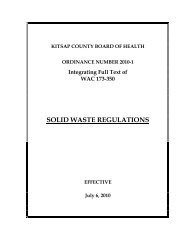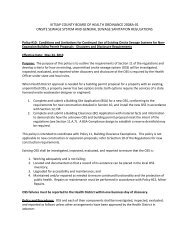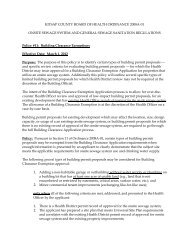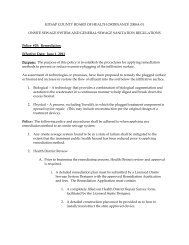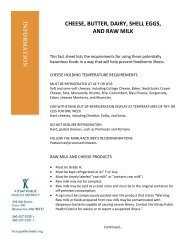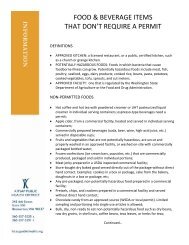ANNUAL REPORT 2011 KITSAP PUBLIC HEALTH DISTRICT
ANNUAL REPORT 2011 KITSAP PUBLIC HEALTH DISTRICT
ANNUAL REPORT 2011 KITSAP PUBLIC HEALTH DISTRICT
You also want an ePaper? Increase the reach of your titles
YUMPU automatically turns print PDFs into web optimized ePapers that Google loves.
ROAD<br />
CHRONIC DISEASE:<br />
The public health challenge of the 21st Century<br />
Both the District’s<br />
Strategic Plan and the<br />
Kitsap Community<br />
Health Priorities include<br />
an expansive strategic<br />
goal that will require<br />
a complete change in<br />
community norms, and a<br />
tremendous effort on the<br />
part of the District and<br />
its community partners:<br />
the prevention of chronic<br />
diseases.<br />
Chronic diseases—such as heart disease, cancer, and diabetes—<br />
are the leading causes of death and disability in the United States.<br />
Almost 1 out of every 2 adults has at least one chronic illness.<br />
Four modifiable behaviors—lack of physical activity, poor nutrition,<br />
tobacco use, and excessive alcohol consumption—are responsible<br />
for much of the illness, suffering, and early death related to chronic<br />
diseases.<br />
“The best way<br />
to predict<br />
the future is to<br />
create it.”<br />
Peter F. Drucker<br />
Over the past few decades, we have witnessed a steep rise in<br />
obesity, a risk condition that leads to chronic illness, in both adults<br />
and children. In Kitsap County, approximately 60% of all adults are<br />
either overweight or obese, a staggering statistic.<br />
Additionally, the U.S. spends significantly more on health care than<br />
any other nation on the planet, yet our average life expectancy is far<br />
below many other nations that spend less on health care. Chronic<br />
disease accounts for approximately 70% of these U.S. health care<br />
costs, yet we invest only 1% of health spending on prevention, a<br />
paltry sum.<br />
Adopting healthy behaviors is much easier if we establish<br />
supportive community norms and adopt a philosophy that embraces<br />
health in all policies and settings. We must promote community-wide<br />
approaches that support healthy living for individuals, families, and<br />
communities.<br />
Background photograph by Michael Drew



